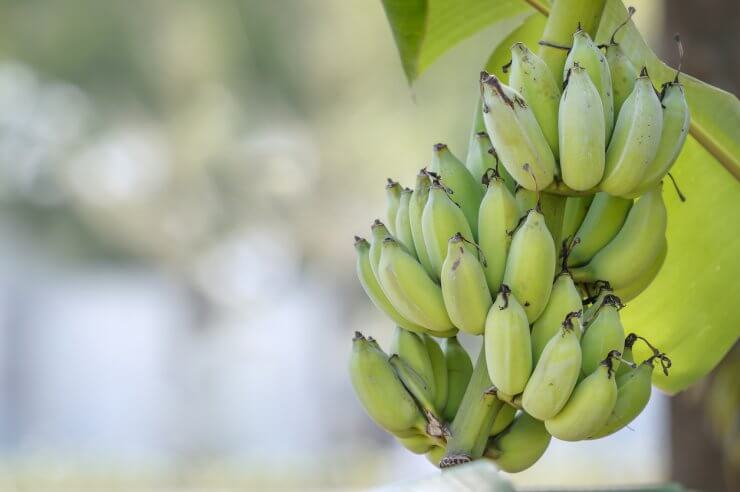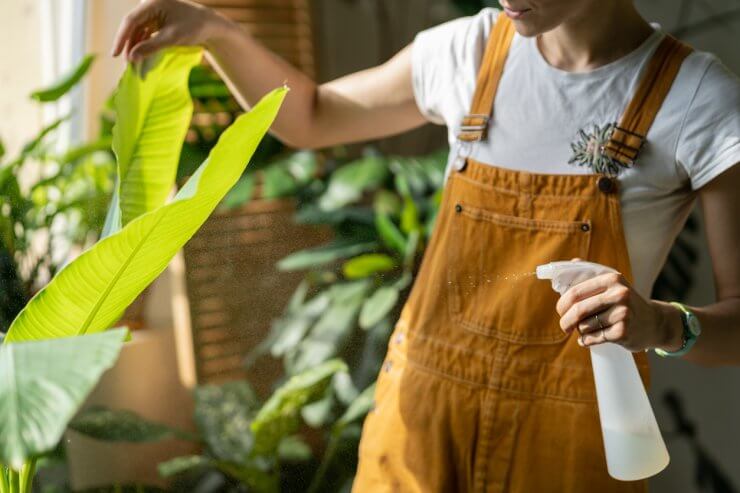
Growing bananas indoors
If you’ve seen a banana tree in the wild, you might think the idea of growing bananas indoors is ludicrous. Depending on the variety, “average” banana trees can grow anywhere from 20 to 40 feet tall.
They grow quickly, too. It’s not unheard of for banana plants to grow in the neighborhood of three feet per month. Why so fast? To begin with, even though we often refer to banana plants as trees, they are technically herbs, since they don’t have a woody stem.
Of course, fast-growing can be nice when you’re hoping to get delicious fruit for your smoothies or cereal! In some cases, you could harvest bananas in less than a year. In the meantime, banana plants bring a luxurious, tropical vibe to your home. With bright, lush leaves and unique, richly-colored flowers, banana plants are a vibrant addition to any room.
You really can’t go wrong growing bananas indoors. Whether for aesthetic reasons or the fruit (or both!), this is a plant that promises to bring joy.
Discover the 3 top options for growing vegetables indoors—when you access the FREEBIE Growing Vegetables Indoors for Beginners, right now!

What you need to know about growing bananas indoors
While banana plants grow easily outdoors in USDA zones 10 and higher, some cold-hardy varieties may grow outdoors in zones 8 and 9. Otherwise, if you want your very own banana plant, you’ll be growing bananas indoors. Here are some tips to help.
1. Choose the right variety. There are hundreds of varieties of banana plants. Some bear fruit, and others are purely ornamental. Some are entirely too large to keep indoors. Even within those constraints, there are still multiple varieties to choose from. The Dwarf Cavendish might be the most well-known, but The Pineapple Banana produces a tangy fruit, and the plant tops out around 7 feet. The Texas Star Banana plant matures around 8 feet and produces sweet, medium-sized fruit. Or there’s the Grand Naine Banana plant that produces creamy, sweet fruits and grows in the range of 6 to 10 feet tall.
2. You need sunlight. Lots and lots of sunlight. Remember, these are tropical plants we’re talking about. Even if you’re primarily growing bananas indoors, you’ll still want to find them the sunniest spot possible. If you can’t provide 8 or more hours of sunlight, you might need to consider a grow light.
3. Keep it warm. Again, tropical plants. They’re used to temperatures in the 80s and up. Will your home be that warm? Probably not. But do keep your banana plant away from the air conditioner.
4. Choose your pot wisely. You can use a pot made of terra cotta, ceramic, plastic, or whatever material you like. BUT! When you’re growing bananas indoors, it’s important to make sure the soil can drain easily. Bananas like moisture, but they don’t like standing in soggy soil. So whatever style or type of container you choose, make sure there is plenty of drainage.
5. Choose your soil wisely. Banana plants aren’t incredibly picky when it comes to soil composition. What they do need, however, is soil with plenty of organic material, like compost. Additionally, you absolutely need well-draining soil. Banana plants are highly susceptible to root rot, so a nice, loose soil is especially helpful.
6. Get a big ole pot. Bananas grow quickly, so you’ll likely do some frequent repotting until your plant reaches maturity. Don’t start off with a pot that’s too large, as you want to make sure your soil can drain easily. Eventually, though, you may need a 15-gallon pot or something even larger. You’ll also want a small stand on wheels so you can take advantage of the next tip.
7. Take it outdoors. Just because you’re growing bananas indoors doesn’t mean you can’t take it outdoors. Once you get into summer and the nighttime temperatures stay above 65 or 70 Fahrenheit, roll your banana plant outside onto the patio or porch. Make sure it’s in a sheltered but sunny location, as the leaves can be sensitive to strong winds. Your plant will enjoy the fresh air and warmth as much or more than we all do.
8. Fertilize it. Follow the instructions for your specific variety of plant here, but generally speaking, banana plants like plenty of nutrients. During the growing seasons of spring and summer, you can expect to fertilize your plant about once per week. Just watch out for fertilizer burn.
9. Water regularly. It’s hard to tell you how often to water your banana plant. Container material, temperature, soil composition, and relative humidity all factor into how quickly the soil dries out. Bananas enjoy moist, well-drained soil. If you can, try and find that balance where the soil doesn’t entirely dry out, but is also not excessively wet.
10. Keep it humid. When you’re growing bananas indoors, try to keep the plant grouped together with any other tropical plants you have. Either mist the leaves regularly or run a humidifier nearby.
I’ll leave you with one more tip that’s not so much about the banana plant as it is about enjoying the plant. Be patient. Even though banana plants grow quickly and can produce fruit in short order, these are tropical plants. They thrive in hot, humid climates with lots of bright sunshine.
When you’re growing bananas indoors, the situation is very different. It may take more time than you expect for the plant to bear fruit. In some cases, even fruiting varieties may not bear fruit indoors. While it may be a little disappointing, don’t give up on your plant. Appreciate it for the beauty and vibrancy it brings to your space.
Have you tried growing bananas indoors? What kind of results did you get?
Discover the 3 top options for growing vegetables indoors—when you access the FREEBIE Growing Vegetables Indoors for Beginners, right now!





I’m very happy with this app. My gardening experience and quality of my produce have improved immensely. Although my garden area is small, I have been able to manage it much easier. It’s become so easy, I’m considering expanding the size of my garden a little at a time.
I like this APP-lots of very useful information
do you have any info on growing meyers lemons??? what fertilizer to use for them? thanks